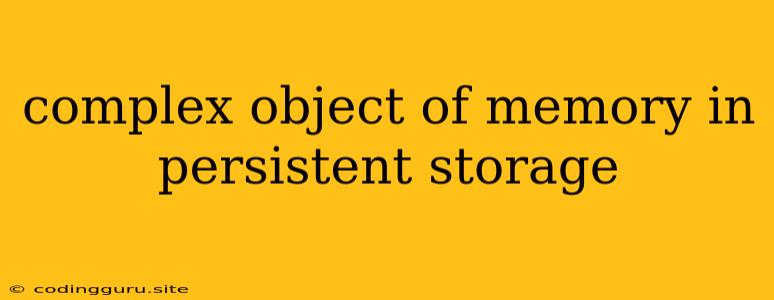The Challenge of Storing Complex Objects in Persistent Storage
Storing complex objects in persistent storage is a common task faced by developers across many programming languages and frameworks. Whether it's managing user profiles, e-commerce data, or intricate game states, the need to retain these objects beyond the lifespan of a program is paramount. However, the process of efficiently and reliably storing complex objects in a way that can be easily retrieved and manipulated poses significant challenges.
Let's explore these challenges and dive into techniques that help us overcome them.
What Makes Complex Objects Difficult to Store?
Complex objects often encompass a variety of data types, potentially including nested structures, arrays, and even references to other objects. This inherent complexity can make direct serialization into a format like JSON or XML inefficient or even impossible.
Here are some common problems:
- Data Structure Complexity: The intricate relationships between different parts of a complex object can be difficult to represent in a flat storage format. This can lead to data redundancy and make data retrieval cumbersome.
- Object References: Storing objects that reference other objects requires careful handling. If not done properly, circular references can lead to infinite loops during serialization or deserialization.
- Data Types: Many programming languages support a wide range of data types, including custom objects, binary data, and even functions. Storing these diverse types in a persistent format can be challenging.
- Mutability and Versioning: Complex objects often change over time, requiring mechanisms to manage different versions of the data.
Techniques for Storing Complex Objects
Fortunately, several techniques and tools have emerged to address these challenges:
1. Object-Relational Mapping (ORM)
ORM frameworks provide a powerful abstraction layer that allows developers to interact with databases using object-oriented paradigms. They map objects in your code to tables in a relational database, taking care of the translation between objects and the database schema.
Benefits:
- Simplified Data Access: ORMs streamline database interactions, reducing the need to write complex SQL queries.
- Data Integrity: They enforce database constraints and relationships, promoting data consistency.
- Object-Oriented Approach: ORMs enable working with data as objects, aligning with modern software development practices.
Drawbacks:
- Performance Overhead: The abstraction layer introduced by ORMs can potentially lead to performance penalties, especially in high-throughput applications.
- Limited Flexibility: ORMs can sometimes impose limitations on the way data is stored and accessed.
2. Document Databases
Document databases like MongoDB store data in JSON-like documents, which can effectively represent complex objects. They offer flexibility and scalability, making them well-suited for storing structured and semi-structured data.
Benefits:
- Flexibility: Document databases accommodate data with varying structures, enabling schema-less design.
- Scalability: They are known for their scalability, handling large amounts of data and high traffic efficiently.
- Query Capabilities: Document databases support rich query languages, allowing for efficient data retrieval based on document structure.
Drawbacks:
- Schema Enforcement: While schema-less, they may lack strong data integrity enforcement.
- Complex Relationships: Managing complex relationships between documents can be challenging without dedicated tooling.
3. NoSQL Databases (Other Options)
Beyond document databases, NoSQL databases like Cassandra, Redis, and Neo4j offer diverse features and capabilities tailored to different storage needs. For example, Cassandra excels at handling high write throughput, while Redis provides fast key-value storage, suitable for caching and session management.
4. Serialization and Deserialization Libraries
Libraries like JSON, YAML, and Protobuf facilitate the conversion of complex objects into serialized representations, enabling their storage in files or databases.
Benefits:
- Portability: Serialized data can be easily transferred across different systems and environments.
- Simplified Data Storage: Libraries handle the complex process of converting objects into a persistent format.
Drawbacks:
- Data Format Limitations: Some serialization formats may not be well-suited for representing all data types effectively.
- Manual Management: Developers need to manage the serialization and deserialization processes explicitly.
5. Specialized Object Storage Solutions
For highly specialized use cases, custom object storage solutions can be developed or employed. These solutions might involve custom data structures, optimized serialization techniques, or specialized database systems.
Choosing the Right Approach
The optimal approach for storing complex objects depends on various factors, including:
- Data Structure: The complexity and relationships within the object.
- Data Size: The volume of data being stored.
- Performance Requirements: The need for fast data access and retrieval.
- Scalability: The potential for future data growth.
Conclusion
Storing complex objects in persistent storage is a fundamental challenge in software development. By carefully considering the various techniques and tools available, developers can choose the approach that best meets the specific needs of their application, ensuring data integrity, scalability, and efficient data access.
